Last Updated on: 12th November 2019, 03:45 pm
Zhangjiajie National Forest Park is one of China’s, and the world’s, most breathtaking natural scenic areas. Situated in the northwestern part of Hunan Province, the massive park takes up over 11,900 acres. The park is known for its huge sandstone pillars formed by many years of water erosion, and there are a near countless number of them throughout the area. Zhangjiajie even inspired the scenery for the 2009 film Avatar, but no Hollywood film can act as a substitute for visiting the real thing.
It would probably require at least 5 days to explore Zhangjiajie National Forest Park in full, though many spend 2 days here. I spent three full days hiking through the park, which felt like a good amount of time. Two should be plenty, though, if you choose your hiking routes wisely.
Before my visit, I could only find articles about the park’s main highlights. I really had no idea about which particular hiking courses I could fit into a single day, or the best order in which to see things. The staff at my hotel gave me some great tips upon my arrival, but it still would’ve been nice to have access to this info in advance.
That’s why I decided to make a comprehensive guide which details three different full-day walking routes you can go on during your time at Zhangjiajie. Divided into three articles, the first part below features the Yuanjiajie and Yangjiajie areas – the most strenuous but also the most memorable day of my trip.
I also dedicated an entire day to the Tianzi Mountain area and another to Golden Whip Stream and Huangshi Village. These guides are intended to give visitors a comprehensive rundown of the important practical info you need to know when visiting the park, together with a virtual walkthrough of the trails and their various highlights.

Zhangjiajie National Forest Park: Essential Info
The following guide is intended for those who like to hike, those who want to make efficient use of their time at the park and also those who like to save money. Before you visit Zhangjiajie National Forest Park, there are a number of important things you should know.
TICKETS: Park entry costs ¥248 RMB and is valid for four days (but double check before your trip, as this has changed in the past). To save time, ask your hotel to pick one up for you in advance so you don’t have to wait in line on your first morning. These are pretty high-tech cards which can only be activated by your fingerprint.
GETTING AROUND: Aside from walking, visitors can get around the park by hopping on free shuttle buses. This is often required to get from one area to another. The park, however, consists of two levels. The lower ground level and the upper mountaintop level. The free buses can only take you from one point to another within the same level. To move from one level to another, you only have two options: hiking or paying extra for cable cars or elevators.
EXTRA FEES: There are various cable cars that cost ¥76 per ride. The massive Bailong Elevator, meanwhile, costs ¥72. And there’s also a tram in the Tianzi area for ¥24. Over the course of three days, I only paid for transport one single time. This was due to time constraints, as visitors must leave the park in the evening.
GENERAL TIPS: The park opens at 7:00 each morning and you should start each day as early as possible. (When traveling in China, it’s amazing how many frustrations you can avoid by following this one simple tip.) It’s best to have some kind of rain jacket or umbrella with you in case of a downpour. And to save some money, buy some snacks in town the night before.
Learn more about transport to the Wulingyuan area and where to stay at the very end of the article.
Yuanjiajie & Yangjiajie Itinerary Summary
Take the bus from the Wulingyuan Entrance to Water Winding Four Gates (水绕四门). Walk along the Golden Whip Stream (金鞭溪) and then turn right at ‘Getting Together From Far Away’ (千里相会) to start the ascent up. Enjoy the views (and solitude) on the way up to Yuanjiajie (袁家界). At the top, visit places like the Ecstasy Terrace (迷魂台) , Hallelujah Mountain (哈利路亚山) and the Greatest Natural Bridge (天下第一桥).
When finished, take the free shuttle bus to Yangjiajie (杨家界索道上站 stop). Visit the Natural Great Wall (天然长城), and then walk through Wulong Village (乌龙寨). After hiking all the way to Tianbo Mansion (天波府), return the same way you came. Then hike all the way to Air Corridor (空中走廊). When finished, you’ll have to retrace your steps back to the bus stop.
Ride the bus to the Tianqiao Stop, then walk several minutes over to the ‘Enchanting Stop.’ Ride the bus to the Bailong Elevator Stop (百龙天梯), pay the ¥72 RMB fee, and take the elevator down to the lower level (no hiking paths around here). Finally, take another bus back to the Wulingyuan Entrance.
Total time: 9 or 10 hours.

Golden Whip Stream
I arrived at the Wulingyuan Park Entrance some time after 7:00. Luckily, the line to get into the park was relatively short. But upon entering the bus departure area, it wasn’t exactly clear which bus I needed to take, as they only displayed numbers and not names.
I approached a driver and pointed to ‘Water Winding Four Gates’ (水绕四门) on my map and he indicated which bus I needed to catch. Fortunately, I was able to find an empty seat for the 15 – 20 minute ride. It would be the last time I’d sit down for quite some time. And so I began my brief hike through Golden Whip Stream.
Golden Whip Stream is the most popular scenic area of Zhangjiajie National Forest Park’s ground level. In total, it stretches out to over 7 kilometers. And as the name suggests, a paved trail takes visitors along a tranquil stream for the course’s entire duration.
Starting the hike, I met a Chinese university student who was doing some solo travel in the region during his school break. We chatted about various topics in English as we passed by some pavilions and lookout points. Disappointingly, it was a foggy morning, and glimpses of the sandstone pillars in the distance were far from clear.
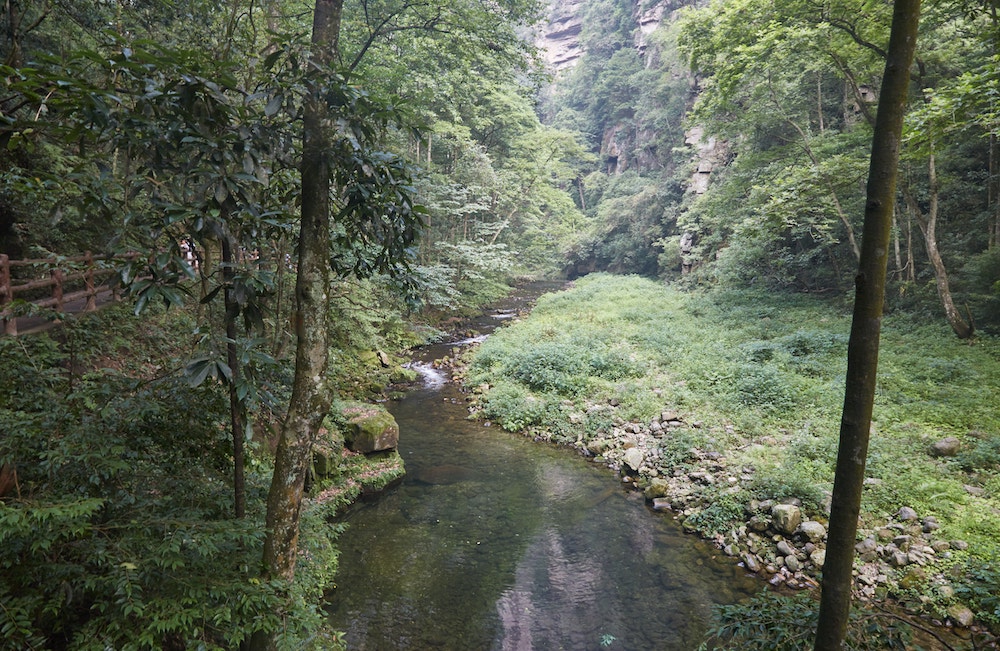





The further along we got, the quieter things became. We passed by some more landmarks, including the Collovial Rock, a huge piece of sandstone that once fell off of a pillar a long time ago.
I would eventually do a much more thorough tour of Golden Whip Stream on my third day at the park, when I’d walk it all the way to get to Huangshi Village. For now, though, it was time to start the steep hike up the mountain. I said goodbye to the student, and at the point on my map labeled ‘Getting Together From Far Away’ (千里相会), approached the staircase on my right-hand side.



Climbing Up
As tiring as it was, the hike up the mountain turned out to be one of the highlights of my day. While I occasionally passed a few small groups of other hikers, I almost had the whole area to myself. And as I gradually got higher, the fog slowly started to dissipate.



It was around 20 minutes into the hike, when, peaking through some trees, I finally got my first proper view of the sandstone pillars. While it’s one thing to see them in photographs, you can’t really grasp their size until they’re right in front of you. And I was also taken aback by the scale and vastness of the park overall. All I could think at the time was ‘wow.’







The higher I got, the more breathtaking the views. I’d only been in the park a few hours, and the journey out to Zhangjiajie was already well worth it. Simply put, it was one of the most stunning and unusual landscapes I’d ever laid eyes on.


And I was somewhat taken aback by how quiet everything was. Before visiting the park, I’d read all sorts of grumbling reports on how crowded the place could get, but the trails around me were almost entirely empty.
I discovered a number of staircases taking me up and down to various viewing platforms. I took my time at each one, and I never had a problem finding my way back to the main trail.

In total, the hike up lasted a few hours, but with so much to see, it felt much shorter. Checking the time, it was already 10:30am. I sat down on a bench for a little while to rest my legs and I opened some snacks I’d brought from town. I then checked out a few other small, almost hidden viewing platforms made out of the side of the rock.
Returning to the main trail, it wasn’t entirely clear when I’d officially reached the top level. But when I saw the large groups wearing colorful hats in the distance, it was then that I knew. I took in the peaceful atmosphere for a few more minutes before heading straight into the storm.





A Walk Around Yuanjiajie
The area known as Yuanjiajie, which translates to ‘Domain of the Yuan family,’ is arguably the most popular section of Zhangjiajie National Forest Park. In quick succession, you’ll encounter several of the park’s most well-known landmarks that get mentioned in just about every article on the area. Expect to spend a couple hours here in total.


One of the first main scenic areas of the district is the Rear Garden. Supposedly, a Chinese poet who once visited the area compared it to the classical gardens of Suzhou. Chinese gardens are the result of man’s attempt to capture the essence of nature within a confined urban space. But upon viewing this part of Zhangjiajie, the poet was reminded that a manmade landscape can never match raw nature in all its glory.
The local Tujia people, China’s eighth largest ethnic minority, have also long revered this scenery. In fact, they even surmised that the souls of their ancestors ended up here.




Next, I came across one of the area’s main platforms. I’ve seen it translated to English as everything from ‘The Lost Soul’s Platform’ to the ‘Ecstacy Terrace!’ But in Chinese it’s written as 迷魂台 and pronounced as Mihun Tai.
The platform is an excellent place to see all sorts of pillars of various shapes and sizes, and is often crowded for good reason. Approaching the area, I waited patiently for the selfie takers to finish their shots so that I could photograph the spectacular scenery.
But I couldn’t keep waiting forever, and eventually decided to go on ahead. At crowded touristy spots in China, you’re always going to be in the way of at least one person’s selfie at any given moment. A nearby woman angrily berated me, but fortunately I had no idea of what she was saying. It seemed like she was trying to convey that the Ecstasy Terrace was all hers.







Soon I arrived at the most famous individual pillar in the entire park: Hallelujah Mountain. Named after the Zhangjiajie-inspired Hallelujah Mountain range in the Avatar movie, the pillar stands at 1,080 meters tall. Locally, it’s known as ‘The Pillar Which Connects Heaven & Earth,’ or just the ‘Heavenly Pillar.’
It stands tall in an area slightly separate from neighboring pillars. And it’s easily recognizable by the vegetation covering its top, almost like a head of hair.



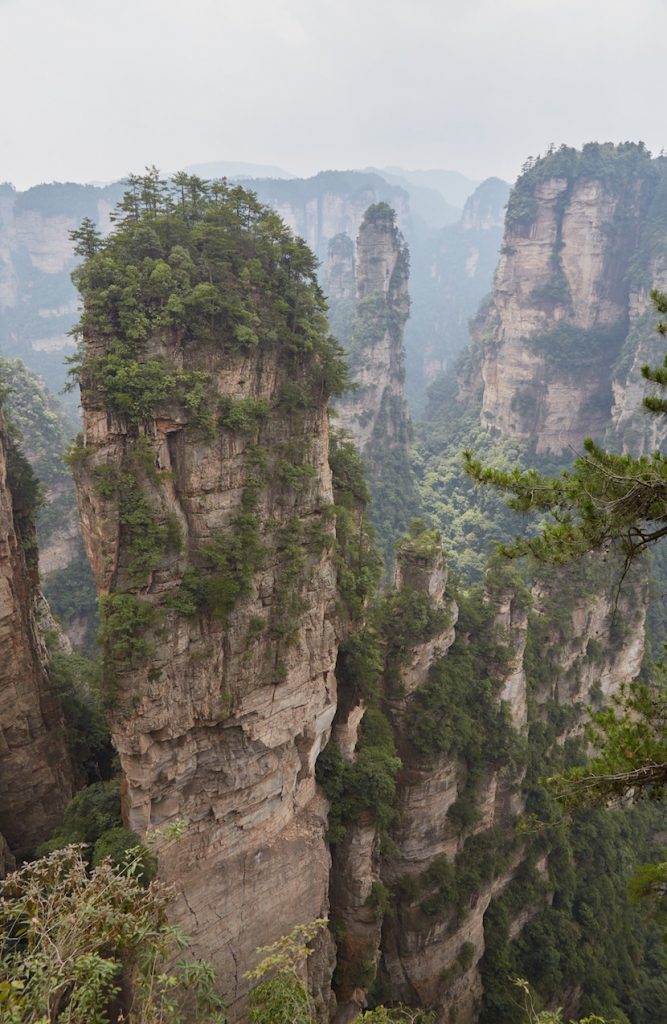
Moving along, I passed by the ‘Double Dragon Spring.’ There are even some spouts in the shape of dragon’s heads where you can refill your water bottle. If you’re not feeling that brave, there are plenty of places to purchase water and snacks in the area as well. As you would expect, you’ll be paying ‘mountain prices,’ but the costs here aren’t too outrageous.
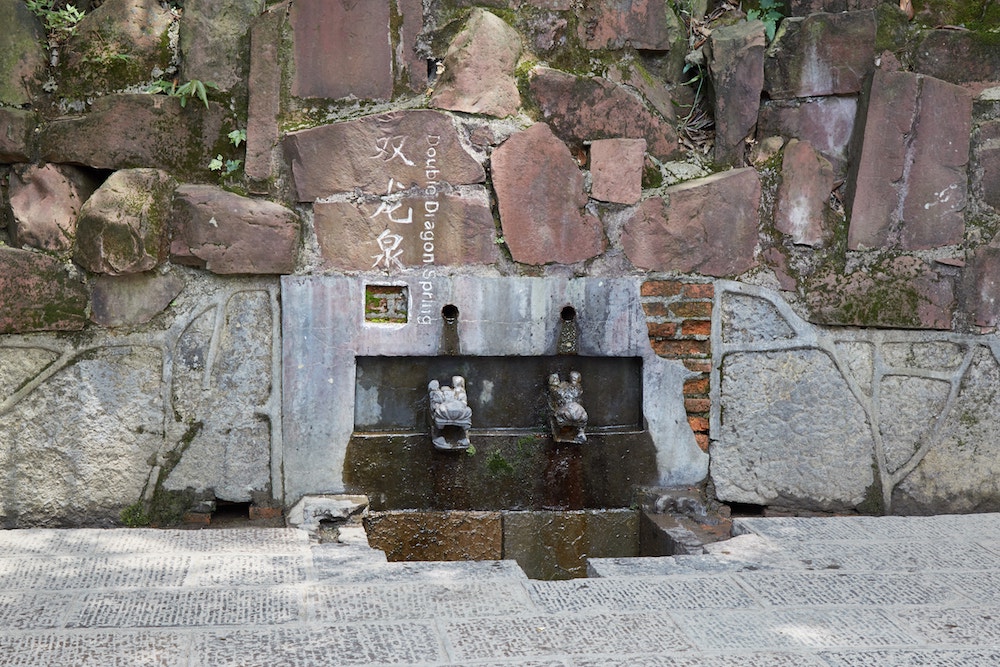



Before long I arrived at the last major highlight of Yuanjiajie: ‘The Natural Bridge.’ At this unique spot, two sandstone pillars are conjoined together completely naturally. Supposedly, the bridge was formed ages ago due to a combination of water erosion and part of the rock collapsing, not unlike the Heaven’s Gate cave of nearby Tianmen Mountain. Locals even like to call this bridge the world’s first.
While the bridge is best appreciated from afar, you can also walk across it. Walking to the other side, I came across even more viewing platforms which, unsurprisingly, offered excellent vantage points of the otherworldly scenery.



After checking out a few more scenic spots like the aptly named ‘Thousand Meter Cliff,’ I set out for the nearest bus station. It was time to explore a brand new area of the park known as Yangjiajie.




The Natural Great Wall
The wait for the bus wasn’t too long, and after a ten-minute ride I got off at the 杨家界索道上站 stop (you might also see it labeled as 乌龙寨口). I had plans to visit a number of different areas in Yangjiajie, my first stop being the Natural Great Wall. Note that opposed to Yuanjiajie, through which you can simply walk from one end to another, each trail of Yangjiajie requires you to retrace your steps, walking back the same way you came.
The walk to the wall only took around ten minutes, and this viewpoint turned out to be one of the most amazing scenes of the entire Zhangjiajie National Forest Park. As the name suggests, the sandstone here appears to form long, narrow walls as opposed to the tall obelisks found elsewhere. The technical term for each wall is a ‘peak dyke.’

Wulong Village
Walking back the way I came, I turned right at the main central trail of Yangjiajie. Eventually, the trail split into two, and I chose to go right. This path would take me through an area known as Wulong Village, with the final destination being the Tianbo Mountain lookout point.




Wulong Village is a fun little area to explore. The ‘village’ is actually a steep sandstone rock with very flat edges. At some points, you’ll need to squeeze through a narrow 60m passageway in between two stone walls. This section is known as ‘Thread Valley.’ And at other points, you’ll find yourself looping around the rock during your ascent, as if you were climbing a spiral staircase.
As many of the pathways, metal bridges and ladders are very narrow, you’ll have to wait for others to come up or down before you can move on ahead. But as Yangjiajie is much less touristy than Yuanjiajie, it’s generally less crowded and people are much more patient and friendly. Most had big smiles in their faces, in awe as the majestic scenery gradually unraveled.
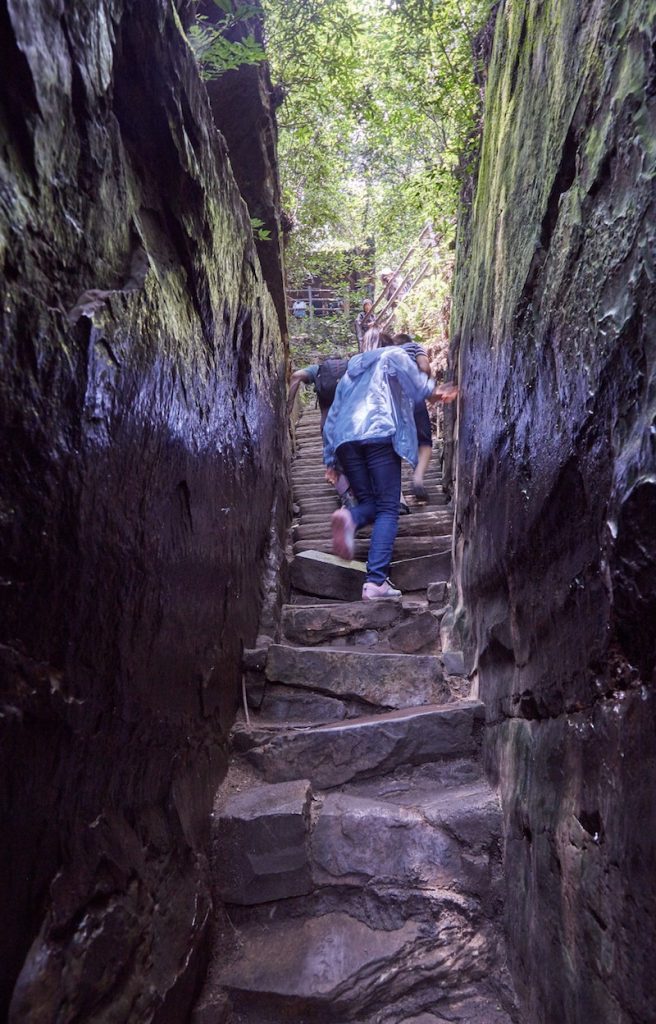




After roughly half an hour, I made it to the Tianbo Mansion viewing platform. If the scenery looks familiar, it’s because this is actually the opposite side of the ‘Natural Great Wall’ peak dykes. But even though they’re the same rocks, the different vantage point is still worth the trek.




But what exactly is a Tianbo Mansion? Supposedly, Yangjiajie was named after a popular Chinese fictional tale about a family of generals named Yang. As such, many of the landmarks around the area were named after things from the story, with Tianbo Mansion being the Yang family home. So it turns out that Avatar isn’t the only fictional inspiration for the names around the park!



Air Corridor
Walking all the way back, it was time for one more excursion. The next trail, the longest of the Yangjiajie area, would conclude at Air Corridor (空中走廊), yet another lookout point but one with brand new scenery. It was getting late in the afternoon now, and hardly any other tourists were in sight. Even the snack vendors were closing up shop. And so I moved relatively quickly, aware that I had to get down and grab a bus before dark.



The trail here was surrounded by relatively dense greenery on either side. But about halfway through, I arrived at a lookout platform called ‘Reaching the Sky in a Single Bound.’ While the main attraction here is supposed to be the tall narrow pillar over to the right, the scene is best taken in as a whole.
Heading back to the main trail, I ran into a couple of other foreign tourists I’d spoken to briefly at Tianbo Mansion. We were headed in the same direction and so we formed a small group. It seemed as if we were the final three people left in Yangjiajie.

Reaching the end, we noticed a fantastic view of some distant mountains in between a narrow valley. There were two trails now – one going almost straight down, and another steep trail going up. We chose to go up which soon proved to be the right choice.
We arrived at the Air Corridor as the sun was getting lower in the sky. Furthermore, the arrival of some dense gray clouds in the distance added some drama to the scenery.




We had the little platform for ourselves. It had been everyone’s first day hiking at Zhangjiajie National Forest Park, and none of us could get over how beautiful the place was. After 15 minutes or so at the platform, we decided it was time to start heading back.
But curious as to where the downward path would eventually lead, I headed down for a few minutes to catch a preview. But there was no indication of where it would take us, and so we ultimately decided to go back the way we came – all the way to Yuanjiajie.






Back Down
At this point the only way to get back down for free would be to walk through the entirety of Yuanjiajie, and hike back down the same path I’d walked up. Furthermore, there would be another 30 minutes or so of walking through the Golden Whip Stream to finally get to the bus stop around there. Given the time, we had no choice but to shell out a hefty ¥72 RMB for the Bailong Elevator.
While the elevator is promoted as an attraction in and of itself, I wouldn’t think of it that way. While it does offer some nice views, they can’t compare to what you see by hiking up yourself. It also gets very crowded, but at least it fulfills its function well enough.


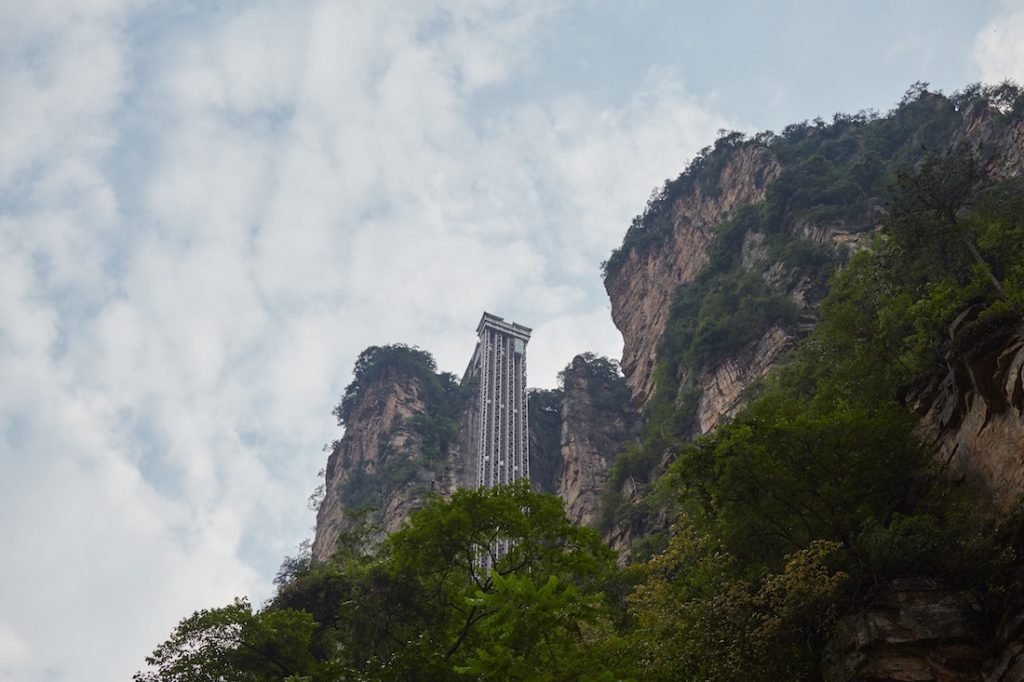
Walking out of the elevator, we found ourselves right in front of a bus stop. We hopped on, and in another 15 minutes or so, we were finally back in Wulingyuan. It was a long and exhausting day, but I was already looking forward to two more.
Additional Info
Planning a trip to see Hunan Province’s various national parks can be confusing. In addition to Zhangjiajie National Forest Park, there’s also Tianmen Mountain which is accessible from Zhangjiajie the city. So which is which?
Zhangjiajie City is the largest city in the general area. It used to have a different name, but the Chinese government renamed it once Zhangjiajie National Forest Park started to become popular. However, the closest town to Zhangjiajie National Forest Park park is not Zhangjiajie City, but a small town called Wulingyuan.
The two towns are about an hour apart. And while I’d definitely recommend seeing both, you should book separate accommodation in each city to make the most of your time. At either park, it’s best to start your day as early as possible.
As mentioned, it’s best to stay in the town of Wulingyuan and not Zhangjiajie City when visiting Zhangjiajie National Forest Park.
I stayed at Zhangjiajie 1982 Chujian International Youth Hostel during my trip and would recommend it. While I normally avoid staying in shared dorm rooms, I make exceptions for national park areas. I was able to sleep pretty well each night and met a number of friendly Chinese and foreign tourists alike.
Other positives include the staff being quite helpful with setting guests up with a park pass and explaining the best routes to take. And most importantly, the hostel is an easy walk from the Wulingyuan Entrance of the park so you’ll have no issues getting there and back each day.
But some of the downsides include booking a room that was advertised as 4 people max, only to check-in and discover 8 beds! Fortunately, though, this didn’t turn out to be a big deal, as it wasn’t always full and the other guests were friendly. Another annoying issue was the lack of a washing machine in the building. They actually make you walk all the way to one of their sister establishments if you need to wash your clothes.
Note that this place also has private rooms if you’re alone or traveling as a couple. And there are of course many other accommodation options around Wulingyuan, a town that pretty much just exists for visitors to the park.
But what about staying inside the park itself? Apparently this used to be possible several years ago, but this was no longer the case at the time of my visit. (Rumor has it that authorities banned park accommodation after part of a trail collapsed.)
With that said, there do appear to be some hotels still secretly operating within the park, which I came across by accident during one of my hikes. Furthermore, there were a number of elderly ladies along the trails mentioning that they had places where I could sleep, but due to the language barrier, I couldn’t get much detail.
So while it may technically possible to stay in the park, I’m not sure how you could arrange this without speaking Chinese.
Wulingyuan has a small bus station. It’s possible to ride there directly from Changsha, which takes 4 hours. However, there are only a few buses running a day. You can also ride directly to and from Fenghuang, but again, there are only a couple buses a day.
Most people will be getting to Wulingyuan via Zhangjiajie City. Buses run very frequently, around every 10 minutes or so, from early morning until 20:30 at night. The ride lasts 70 minutes and costs ¥20 RMB. There’s no need to wait in line at the ticket counter, as you can just pay on the bus.
How to Get to Zhangjiajie City:
Zhangjiajie is accessible from Changsha by either bus (West Bus Terminal) or by train, and the journey lasts about 4 hours. It costs around ¥120.
Zhangjiajie is also reachable by (normal speed) train from many other major cities in China, but given the country’s size, it could be a very long trip. It’s best to take a high-speed train to Changsha first, spend a couple days there, and then head to the national parks from there.
The city is also home to the Zhangjiajie Hehua Airport, which has flights to many major cities throughout China.
As you may or may not be aware, a bunch of major web sites are completely blocked in China. This includes Google, YouTube and social media sites like Facebook. Not only can this be a huge annoyance, but not being able to access your Gmail account or use Google Maps could even cause major problems during your trip.
That is, unless, you have a VPN.
VPN stands for Virtual Private Network. Using one allows you to access the internet via servers in a variety of international locations. Therefore, when traveling in China, you can access the internet through a server in Taiwan or Hong Kong (or anywhere, really) and suddenly start using Google and social media apps like normal again.
I’ve tried out a couple of different companies over the course of multiple trips, and have found ExpressVPN to be the most reliable.
The actual use of VPN’s in China isn’t illegal in itself. However, the Chinese government will often make things difficult for certain VPN companies, and some services may stop working for you out of the blue. That’s why it’s important to go for the most reliable VPN, and ExpressVPN is widely regarded as the best to use in China.

Pin It!










